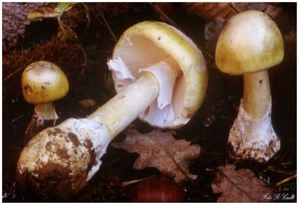We need you! Join our contributor community and become a WikEM editor through our open and transparent promotion process.
Amanita mushrooms
From WikEM
Contents
Background
Amanita phalloides
Clinical Features
Stage 1 (GI)
- Occurs 6-24hr after ingestion and lasts 12-24hr
- The later the onset of symptoms the better the outcome
- GI predominant symptoms:
- Abdominal pain, vomiting and diarrhea (which may become bloody)
Stage 2 (convalescent)
- Occurs 48hr after ingestion and lasts 12-24hr
- Symptoms subside and patient appears better
- Liver deteriorates silently and precipitously (LFTs begin to rise)
Stage 3 (failure)
- Occurs 2-4d after ingestion
- Fulminant liver failure
- Hyperbilirubinemia, coagulopathy, hepatic encephalopathy, hepatorenal syndrome
Differential Diagnosis
Acute hepatitis
- Viral hepatitis
- Acute alcoholic hepatitis
- Acetaminophen toxicity
- Mushroom toxicity
- Crotinarius mushrooms
- Gyromitra mushrooms
- Amanita mushrooms
- Ischemic hepatitis
Mushroom toxicity by Type
| Mushroom | Toxin | Pathologic Effect |
| Amanita | Amatoxin | Hepatotoxicity |
| Coprine | Disulfiram-like | |
| Crotinarius | Orellanine | Delayed renal failure |
| Gyromitra | Gyromitrin | Seizures |
| Ibotenic Acid | Anticholinergic | |
| Muscarine | Cholinergic | |
| Orellanin | Nephrotoxicity | |
| Psilocybin | Hallucinations |
Evaluation
Workup[1]
- Blood sugar
- BMP
- LFT
- Lipase
- Coags, DIC labs
- CBC with differential
- LDH, haptoglobin, reticulocyte
- CK
- Thyroid studies
- Methemoglobin level
- Urine drug screen
- Urinalysis
Management
Immediate therapy
- Activated charcoal
- Some advocate repeated doses during the first 24hr
- Amatoxin undergoes enterohepatic circulation
- Some advocate repeated doses during the first 24hr
- Penicillin
- High doses 1 mil units/kg/d effective in animal studies (inhibits amatoxin uptake)
- Silibinin (milk thistle derivative)
- Mortality benefit
- Free radical scavenger used successfully in Europe
- 5mg/kg over 1 hr, then 25-50mg/kg/d[2]
- N-acetylcysteine admin much like in acetaminophen toxicity[3]
- Mortality benefit
- Load 150mg/kg IV over 15min in 200 cc D5W
- Then 50mg/kg in 500cc D5W over 4hrs
- Followed by 100mg/kg in 1000cc D5W over 16hrs
- Extracorporeal albumin dialysis[4]
- Allow hepatic regeneration or forestall transplantation
Ongoing therapy
- Glucose monitoring
- Hypoglycemia is one of the most common causes of death in early mushroom toxicity
- Liver/renal failure monitoring
- Serial LFTs, chem, coags
- Prepare for liver transplant
- Progressive coagulopathy, encephalopathy, renal failure are indications for transplant
Disposition
- Admit all suspected of ingesting amatoxin containing mushrooms for at least 48hr
- Referral to liver transplant service
See Also
External Links
References
- ↑ Garcia J, Costa VM, Carvalho A, Baptista P, de Pinho PG, de Lourdes Bastos M, et al. Amanita phalloides poisoning: Mechanisms of toxicity and treatment. Food Chem Toxicol. 2015 Sep 12. 86:41-55.
- ↑ Saller, R., Brignoli, R., Melzer, J. and Meier, R. (2008) ‘An Updated Systematic Review with Meta-Analysis for the Clinical Evidence of Silymarin’, Forschende Komplementärmedizin / Research in Complementary Medicine, 15(1), pp. 9–20
- ↑ Lee DS et al. Amatoxin Toxicity Medication. July 21, 2015. http://emedicine.medscape.com/article/1008902-medication#2.
- ↑ Faybik, P., Hetz, H., Baker, A., Bittermann, C., Berlakovich, G., Werba, A., Krenn, C.-G. and Steltzer, H. (2003) ‘Extracorporeal albumin dialysis in patients with Amanita phalloides poisoning’, Liver International, 23pp. 28–33.
Authors
Ross Donaldson, Kevin Lu, Neil Young, Daniel Ostermayer, Claire

